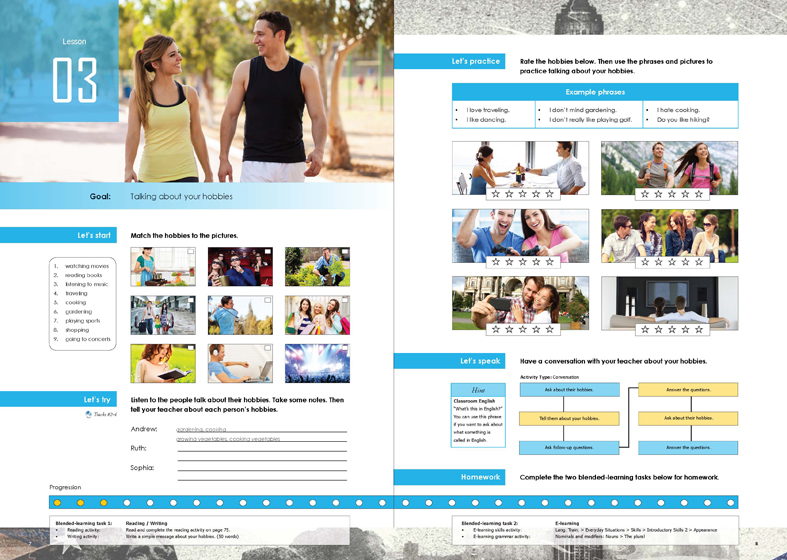
Manuals > General English > Rosetta Stone Advantage > Beginner - Book 1 > Lesson 3
< Previous Lesson | Next Lesson >

By the end of the lesson, the student should be able to have a conversation about hobbies.
Communication strategies:
The student should be able to able to talk about their hobbies using the two steps below:
1) State what your hobby is
2) Share some information about your hobby.
e.g. I like playing video games. I play video games every day.
Words and rules:
The student should be able to use verbs + gerunds together e.g. I like dancing.
Appropriateness:
Register: When talking about hobbies people usually use a casual register.
Social rules: Talking about hobbies is a great way to start a conversation.
Cultural references: "What do you do for fun?" means the same as "What's your hobby?"
Track #2
Hello, my name is Andrew. I’m from London and my hobbies are
gardening and cooking. I like growing vegetables and then cooking
them.
Track #3
Hi, my name’s Ruth. I love music. My hobbies are listening to
music and going to concerts.
Track #4
Hello, I’m Sophia. My hobby is playing sports. I like playing tennis, golf,
and basketball.
Because the lesson touches on the topic of hobbies, you are welcome to introduce some of the following vocabulary if you like.
1) to collect something (v)
2) photography (n)
3) to work out (v)
4) to go to karaoke (v)
5) to do archery (v)
6) to do flower arrangement (v)
7) to play pachinko (v)
8) to do karate (v)
9) to do calligraphy (v)
10) to go to hot springs (v)
Option 1:
Difficulty ★
Type:
Vocabulary introduction
Purpose:
To teach the students some additional phrases they can use to ask about hobbies
Method:
Introduce some of the following phrases then practice using them in conversation
- What are you into?
- What do you do for fun?
- What do you do in your free time?
Option 2:
Difficulty ★★
Type:
Picture speculation
Purpose:
To test the student’s vocabulary level
Method:
Cover the pictures in “Let’s start” then ask the student to describe each picture.
e.g. Top left picture > The woman is cooking.
“Naruhodo” Point
Taking a photo of yourself is called a “selfie” (in reference to the picture on the page in “Let’s Practice”)
Extra questions you might like to ask in the lesson
- What are your hobbies?
- Do you like …?
- What do you like?
- What do you hate?
- What don’t you like?
A speaking hint you might like to use
AAA = Answer Add Ask
> Feel free to use this speaking hint in the “Let’s Practice” / “Let’s Speak” sections of the lesson. This is particularly useful when describing someone’s personality.
Question: What are your hobbies?
Answer: I like watching baseball.
Add: The Giants are my favorite team.
Ask: Do you like baseball
Let’s start
Match the hobbies to the pictures.
Top line (L>R)
Cooking / watching movies / gardening
Middle line (L>R)
Traveling / playing sports / shopping
Bottom line (L>R)
reading books / listening to music / going to concerts
Let’s try
Listen and make a note of the people’s hobbies. After you have checked your answers, tell your teacher about your hobbies.
Track #2
His name is Andrew. He’s from London and his hobbies are gardening and cooking. He likes growing vegetables and then cooking them.
Track #3
Her name’s Ruth. She loves music. Her hobbies are listening to music and going to concerts.
Track #4
She’s Sophia. Her hobby is playing sports. She likes playing tennis, golf, and basketball.
Let’s practice
Ask and answer questions using the phrases and profiles below.
Star guide
1 star = I hate
2 stars = I don’t really like
3 stars = I don’t mind
4 stars = I like
5 stars = I love
5 stars =
A) Do you like going to restaurant?
B) Yes, I love going to restaurants.
Let’s speak
Have a conversation with your teacher about your hobbies.
A) What are your hobbies?
B) I like playing sports and watching TV.
A) What sports do you like?
B) Golf and soccer.
A) How about you? What are your hobbies?
B) I like traveling.